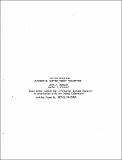| dc.description.abstract | Twenty per cent of all energy consumed in New England and ten per
cent of all energy consumed in the United States is consumed in home
heating. This paper reports on an effort to ascertain the major factors
affecting the consumption of home heating oil. Three general classes of
factors are analyzed: (1) physical and occupant characteristics (number
of rooms, number of occupants, number of stories, amount of insulation,
income level, etc.); (2) external (price, shortage awareness, weather); and
(3) behavioral and physical changes (change in temperature settings, change
in insulation, change in oil burner, etc.).
The study is based on four data series: (1) actual monthly home
heating oil consumption data on 8000 suburban homeowners in suburban Boston; (2) questionnaire responses from 2000 homeowners on their homes' physical and occupant characteristics, as well as changes in physical and occu-
pant behavioral characteristics between 1972 and 1975; (3) monthly weather
data; and (4) heating oil price data. The data is associated with the
years from 1972 through 1975, a period in which marked price changes,
shortages, and behavioral changes occurred, hence providing an opportunity
to study the effects of these various events.
Three models are central to the study:
Model I. A cross-sectional model that depicts consumption per
degree-day as a function of physical and occupant characteristics
of a home.
Model II. A time series regression model that establishes
consumption per degree-day as a function of price and consumer awareness of an energy shortage.
Model III. A cross-sectional regression model that attempts to
explain change in consumption per degree-day from one year to the next as a
function of specific conservation actions such as temperature resetting,
addition of storm windows, etc.
The major findings of each model are as follows:
Model I: House size, age of home, family income, and the presence
of storm doors and windows are all significant factors in predicting
the amount of home oil consumption.
Model II: Estimated values of price elasticity with respect to demand
for residential heating oil and a measure of 'mnpact of shortage awareness
on consumption are determined. This model also demonstrates that there
were substantial savings in consumption corresponding to increases in
price and shortage awareness from 1972-1975.
Model III: he data from the questionnaire indicate that only a few
consumers made physical home improvements; however, the data from the oil
company indicate that a substantial savings (over 12%) in consumption
occurred between the heating seasons 1972/73 and 1973/74. The conclusion
from this data indicates that behavioral changes were the major conservation
actions taken. Model III indicates that the behavioral change of temperature
resetting is significant and the physical change of additional weather
stripping and change of burner are significant. Further study is needed,
however, to determine those behavioral changes that accounted for the major
change in consumption. In addition, this model indicates that different
groups within the sample (e.g., by income level, house characteristics)
display similar conservation efficiency. In addition to the findings of the models, the paper includes (in
Appendix B) a detailed discussion of biases associated with the data.
Major conclusions from that discussion are: (1) our sample is
representative of suburban homes in the Northern United States; (2) the
consumers who responded to the questionnaire were slightly more energy-
conscious and responded slightly more dramatically to price increases
than the general populace; (3) our residential heating oil prices are
representative of those that prevailed in the region; and (4) the heating
seasons 1972 through 1975 were warmer than usual. Trends in the data
indicate that new homes in the sample have a considerable amount of
insulation and the typical single-family house in the sample has storm
windows and doors. | en |
